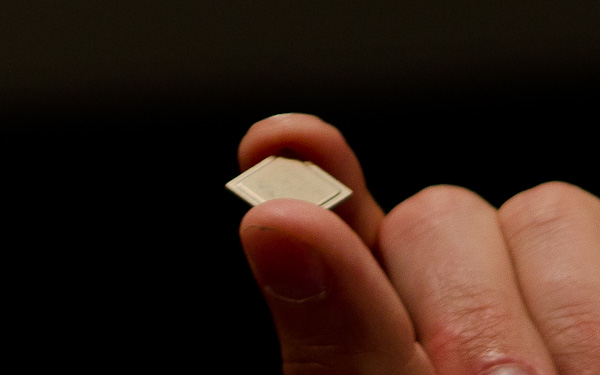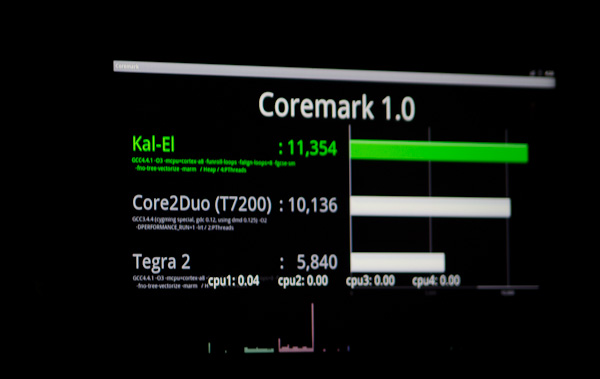NVIDIA's Project Kal-El: Quad-Core A9s Coming to Smartphones/Tablets This Year
by Anand Lal Shimpi on February 15, 2011 9:05 PM ESTFinal Words
The first thing everyone at NVIDIA asked me after I saw Kal-El running was an eager and expected: "well, what did you think?"
On the one hand, we have a clear underdog in the SoC space demonstrating a brand new chip just 12 days after getting it back from the fab. It's functional, it can render 3D games, it can decode high bitrate video and it runs Android today. The word impressive is insufficient to convey the magnitude of what I just described, particularly in the SoC space.
On the other hand, it's still just an announcement. It wasn't too long ago that NVIDIA was struggling to name a single design win. The recent success with LG, Motorola and Samsung is awesome, but it isn't a guarantee of what's to come. That being said, the handset vendors and carriers clearly take NVIDIA seriously today and they would be foolish not to consider Kal-El as it'll be the quickest way to get to quad-core in an Android phone.
Architecturally, Kal-El isn't a huge departure from what we currently have today with Tegra 2. NVIDIA claims a 5x performance improvement over Tegra 2 however that seems a bit optimistic. The 5x gains appear to be from combining the 2x theoretical gain from 2 to 4 cores plus a 3x gain from the new GPU. NVIDIA claims that this is enough to put Kal-El above a Core 2 Duo clocked at 2GHz (see the test results below), however the NVIDIA generated scores seem suspect not to mention that Coremark isn't representative of the sort of workload you'd see on a smartphone/tablet.
If NVIDIA can increase clock speeds a bit we'll see better performance than Tegra 2 on lightly threaded workloads, but I'm not convinced of the gains to be had in single-tasking workloads from four cores in a smartphone/tablet. The bigger gains over Tegra 2 will likely come from any improvements to the memory controller as well as the faster GPU. This being said, NVIDIA does believe that even web page rendering can benefit significantly from a quad-core CPU so I could be very well proven wrong once devices are out in the wild.
If NVIDIA can secure significant design wins with Kal-El based tablets in August of this year and smartphones in Q4 I will be beyond impressed. NVIDIA gets major points for putting on good demos of working silicon today but in this business you need to have devices. For now we play the waiting game. I suspect if you're not taking NVIDIA seriously at this point, you really should be.












76 Comments
View All Comments
heinzr - Thursday, February 17, 2011 - link
How can Nvidia claim that Kal-El offers 5x Tegra performance without getting challenged? The Coremark result is better by less than 2x.tecknurd - Thursday, February 17, 2011 - link
Where is the power consumption numbers? All reviewers that I read still did not post those numbers and I was hoping to see power consumption numbers here, but did not find any. Saying that the Kal-El will have a same power consumption as Tegra 2 does not mean anything to me because I do not know how much power a Tegra 2 realistically consumes. I know how much the BeagleBoard consumes which is around 3 to 5 watts. I expect the PandaBoard to consume about double. If they are going to state the power consumption, I will just predict the power consumption of the Kal-El be around 15 watts. Is this wrong or am I right?Wilco1 - Friday, February 18, 2011 - link
At 40nm, a dual core 2GHz Cortex-A9 uses 2W. So 4 1.5GHz Cortex-A9 cores will use ~2.5-3W. So with the GPU, a total of ~4-5W seems reasonable.While that seems a lot, consider that the lowest power Atom needs 2W per core at 1.5GHz, and that you'll need 4 of those plus a fast GPU to get similar performance.
ioannis - Friday, February 18, 2011 - link
surely Parker should have a place in that chart, don't you think? Or is he more of an AMD/ATI colour-themed hero?IamEzio - Friday, February 18, 2011 - link
the NGP has quad core Cortex A9 ..dagamer34 - Saturday, February 19, 2011 - link
Engadget's video around 3:45 has the rep clearly stating that Kal-El will support high-profile H.264. It'll also handle a Blu-ray rip (and I don't really know of any commonly used video that higher quality than that right now).Link: http://www.engadget.com/2011/02/15/nvidia-announce...